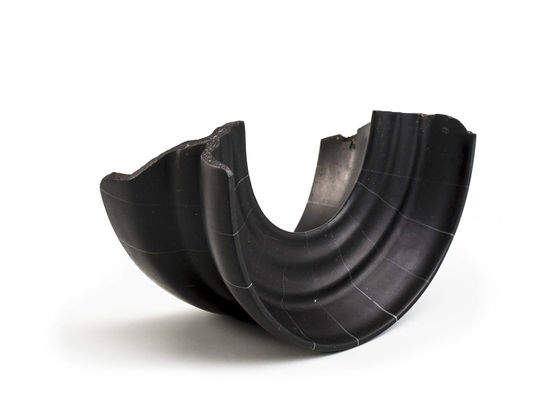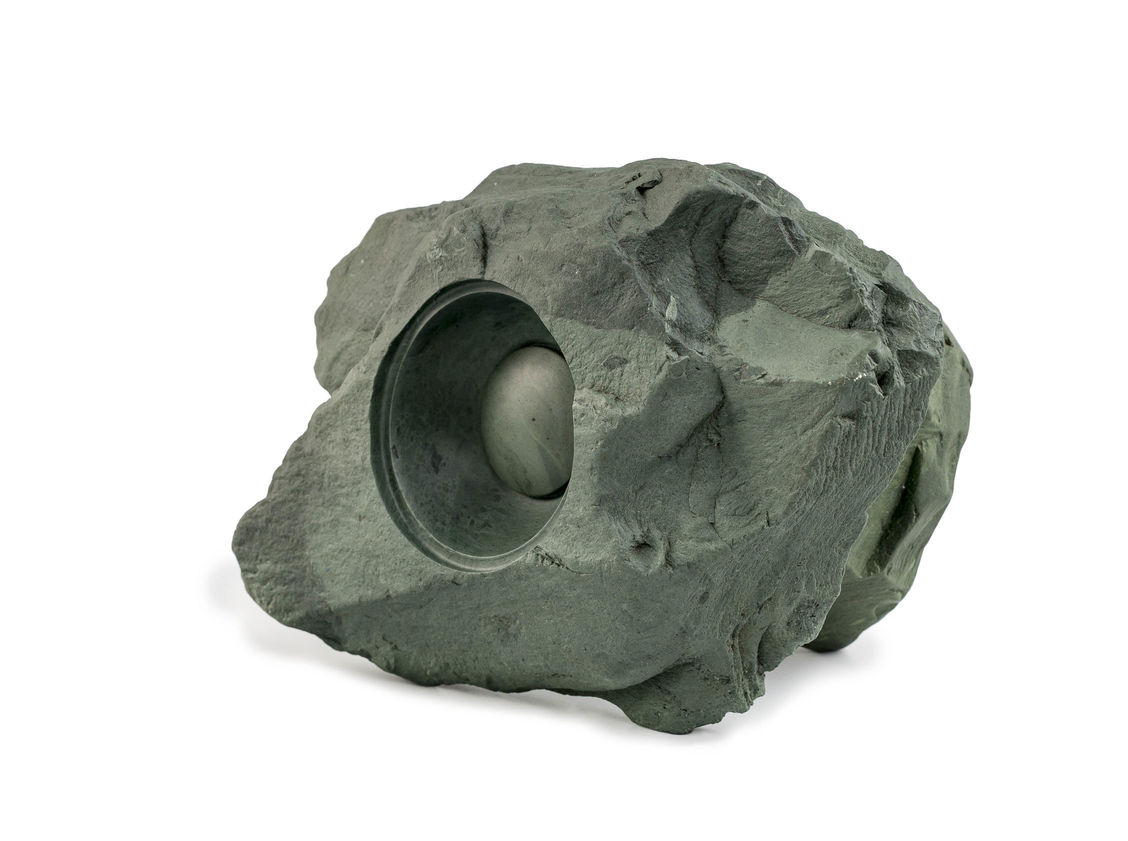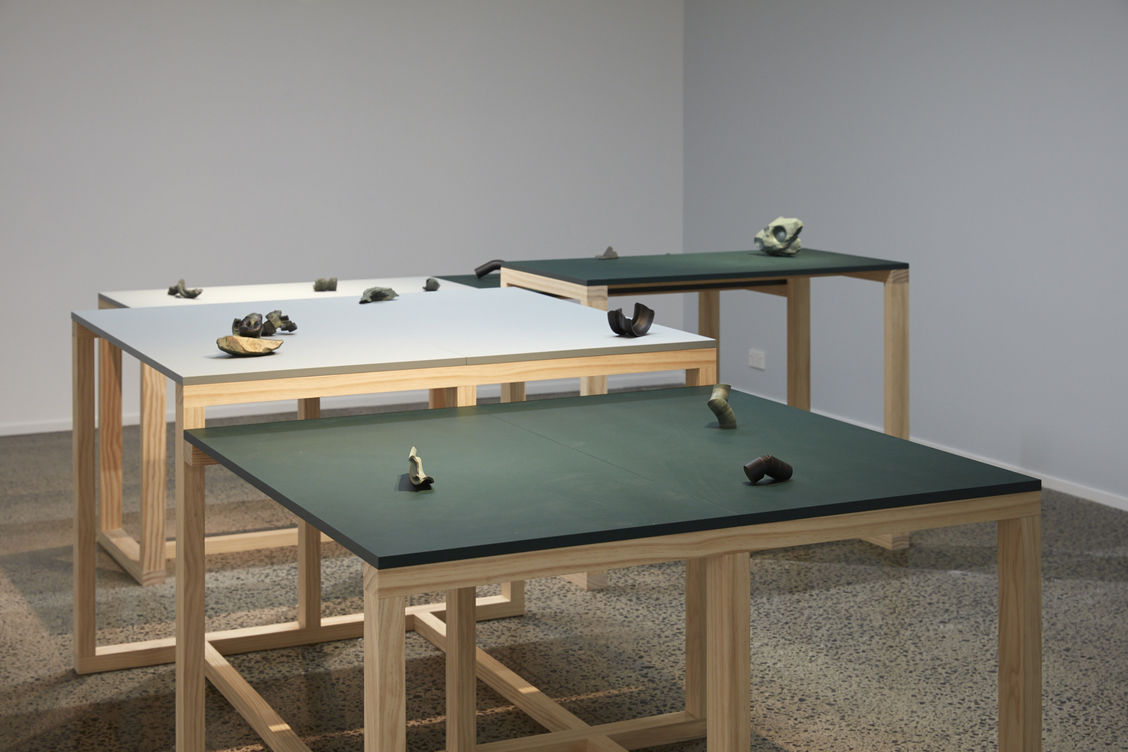-
Author
Elle Loui August -
Date
8 Dec 2017
Essay
Ground Work
Craig McIntosh, 2017
If it is true that Time began, it is clear that nothing else has begun since,that every apparent origin is a stage in an elder process. Those three hundred and twenty millions of years are the time elapsed since the limestone of which Aran is formed was being laid down as layer upon layer of sediment in a tropical sea. But the sea was already ancient and full of intricate lives, the heirs of a previous three thousand million years of evolution.
—Tim Robinson, Stones of Aran: Pilgrimage (1986) 1
In the opening passages of Stones of Aran, writer Tim Robinson commences a meandering narrative of place by laying the immense scale of its formation in full view. The subject of his storytelling is the island of Árainn, the largest of the three Aran Islands located off the west coast of the Irish mainland. Born of early attempts to map the rocky topology and locate physical bearings for its ancient history, his writing traces a circum-navigation of the island and the relationships he strikes up to gain access to local history and lore. A guiding spirit of Robinson’s book is his pursuit of ‘the good step’, an ideal he positions as an ‘adequate’ way of being in the world. This ‘step’ is to be understood as a deft attunement with one’s environment, so that movements, work or simply one’s presence might rise and fall with the pulse and sum total of all — awake to, and seamlessly inseparable from, its ongoing duration. Unfolding episodically at the various stations of Robinson’s journey, it is the work of the writing itself that appears to take up the metre of this ‘good step,’ becoming less a correspondence addressed to or about the island, and more a correspondence with the full body of its world. Portraits of particular locations and inhabitants of the island interweave into a richly layered document in which history, botany, the stacking of place names and historical memory, emerge from the page in concert with the call of sea birds, human sound-forms and the crash of the ocean against stone.
Contemporary with Robinson’s writing of the 1970s and 1980s, yet taking place at a geographical remove, stone work being produced in the context of contemporary jewellery in Aotearoa was pursuing a similar path of inquiry. Shifting attention from the hands to the feet, rafts of maps, implements and geological surveys were being drawn into action as a new generation of carvers and jewellers went out ‘stoning’. As is well recorded in other streams of our local art history, this was a moment in which a great number of Pākehā artists and craftspeople turned their attention to the local wild, seeking to forge their own sense of place and claim an identity, almost as if drawn from the land itself. Reading back through the slim selection of craft literature produced during this time, one can encounter the occasional fog of primal mysticism or neolithic nostalgia, and it is useful to have wider cultural bearings to navigate the complexities born of this moment. This is especially the case as one of the more compromised inclinations to emerge during this period was the desire of many Pākehā makers to engage with Māori lore, cultural and artistic practices, and spiritual traditions. Many working in stone were keenly tuned to a connection with ‘ancient’ knowledge, and actively pursued their curiosity for indigenous stone and cosmologies of art-making other than their own.
The exhibition Pakohe, curated by John Edgar for the Dowse Art Museum in 1985, is exemplary of this moment. Dedicated to work in pakohe (a local variant of metamorphosed argillite) the exhibition project began with a road journey to historic stone-harvesting sites in the South Island of New Zealand, and in conversation with the authorities local to them, the iwi Ngāti Koata and Ngāti Kuia.2 Seeking to retrieve artistic stone practice from being ‘worn out’ by the trivialities of the tourist trinket trade, the exhibition brought together objects of indigenous provenance with newly commissioned pieces from a number of local craft practitioners. Despite the fairest of intentions and a sound delivery, like many other projects of its kind, the exhibition took place in an environment in which the cooption of indigenous symbology and motif were running wild. Instances of cultural appropriation were not restricted to the artistic sphere — they were also fulsomely evident in corporate branding strategies and in the development of iconography for governmental departments.3 In very crude and simple terms, an ethos was in the air which viewed these gestures of engagement as both somehow rightfully earnest and horizontal; that it was possible to reproduce images and objects if you had any form of access to them.
The belief that such forms were free to be appropriated for a generation’s own cultural position and oeuvre appeared to show little respect for the specificities of cultural context and method — and even less accountability for the social, political and historical context in which they were taking place. This was a time when the land march of 1975 and the occupation at Takaparawhā (Bastion Point) were fresh currents in the collective psyche. A time in which surging calls for justice — the return of lands, rights and sovereignty — were growing powerful new voices and roots. The appropriation of artistic forms and imagery could not, for many, be separated from the theft of land and livelihood, nor cultural theft from cultural domination. With the emergence of a new generation of Māori artists, scholars and activists, when the pushback came it was not only timely, but necessary.

Ground Work, Untitled No. 14

Ground Work, Untitled No. 13
The work of Craig McIntosh enters into the lineage of local stonework established at the time of Pakohe from the position of a generational remove. Picking up the research of artists such as Edgar and eminent gemmologist and researcher Russell Beck, McIntosh has followed a multifaceted study of local stone sources that has involved equal parts field work, studio work and critical reflection. In his studio practice over the last decade, McIntosh has dealt seriously with the question of cultural appropriation, and the main drive of his work has been dedicated to developing ethical approaches to working in local stone. As well as questioning the depiction of images in carving, McIntosh has investigated the way in which production methods shape our understanding of objects, and he has dedicated many years of practice to developing composite sculptural techniques in order to work through the ideas and issues that he values in a material form.
A small series of pakohe brooches included in the solo exhibition Construct at The National in Christchurch in 2016 are indicative of this approach. Developed using a combination of reductive and composite techniques, each is detailed with mark-making reminiscent of earth or irrigation works that appear as if scoured, or scorched, into the surface of the stone. For McIntosh these works deal with the human framing of the landscape: in particular, the impact of colonial legal structures on indigenous livelihood and land use, and agricultural and extraction industries on the ancient bones of the land. As jewellery objects, these pieces are intended to activate an identification with very tangible, material histories, implicating both wearer and viewer in a responsive relationship to the present.
The new body of work, Ground Work, draws on abstractions from the fields of architecture and engineering, with surfaces ranging from silken to coarse. As with the conscious directive away from representations of existing indigenous forms, McIntosh’s formal decision to develop work with a variety of surface treatments was in resistance to the traditional level of polish of the lapidary, in order to allow the stone itself a variety of tones and expressions. The resulting lexicon of structural motifs evade clear reference points, yet the works persist in their emphasis on ideas of passage, connection, support and mechanisation. As jewellery objects which cannot be adhered to or worn on the body, they encourage an altered mode of physical engagement; they edge us toward an artistic understanding of the way in which structural forces might be, or are, embodied.
Common to other residents and visitors to Ōtepoti, for much of my own life I have travelled across the causeway at the base of the Otago peninsula that was built from local basalt by political prisoners of Parihaka. From the vantage point of this experience, the question that I understand to be at the heart of McIntosh’s practice is: how to form an image of place, that is made of the very fabric of a place, which can account for such salient truths.
The collection of pipe-like forms included in Ground Work reference ideas of connection, flows of communication and the formation of relationships between distinct sites — or between different cultural perspectives or worldviews. Listening alongside McIntosh’s practice over the last year has involved encountering bodies of knowledge that offer another way of understanding the material fabric, or grain, of these islands. His methods of work bring together geological perspectives with hand-wrought knowledge, a formal understanding of craft histories with knowledge gleaned from walking the land. While not taking the form of a written document as in Robinson’s study of the island of Árainn, and not holding the status we grant to the photograph of documentary ‘proof’, my gentle conjecture is that this body of work remains in its own distinct way a document. An image of place, made of the place, that speaks clearly to its own moment in time.
—
Elle Loui August
- 1.Tim Robinson, Stones of Aran: Pilgrimage, New York Review Books, New York, 2008 (first published 1986), 5 — 6.
- 2.John Edgar, ‘Going Stoning’, Crafts Council Magazine 12, Summer 1984/85, 17 — 19.
- 3.Anna Miles, ‘Peter Robinson, Gordon Walters and the corporate Koru’, ArtAsiaPacific issue 23, 1999, 77 — 81.

Craig McKintosh, Ground Work Exhibtion